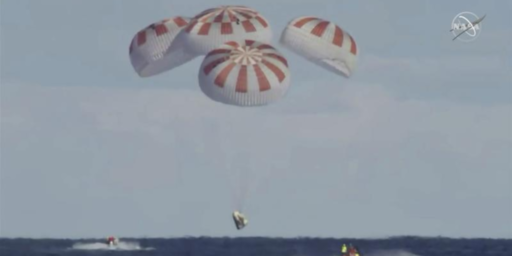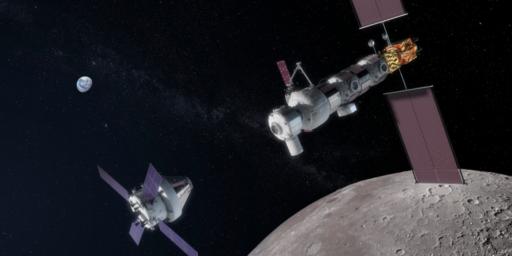NASA Reports Finding Signs Of Liquid Water On Mars
NASA had a potentially significant announcement today.
NASA announced today that probes have discovered evidence of flowing water on Mars, a discovery that could have huge implications for science if it turns out to be correct:
Despite its reputation as a forebodingly dusty, desolate and lifeless place,Mars seems to be a little bit wet even today.
Scientists reported on Monday definitive signs of liquid water on the surface of present-day Mars, a finding that will fuel speculation that life, if it ever arose there, could persist to now.
“This is tremendously exciting,” James L. Green, the director of NASA’s planetary science division, said during a news conference on Monday. “We haven’t been able to answer the question, ‘Does life exist beyond Earth?’ But following the water is a critical element of that. We now have, I think, great opportunities in the right locations on Mars to thoroughly investigate that.”
It may be a tipping point for NASA officials who have been reluctant to speculate about the possibility of contemporary life on Mars.
“I can’t imagine that it won’t be a high priority with the scientific community,” said John M. Grunsfeld, NASA’s associate administrator for science, who said a mission in the 2020s could carry experiments to look directly for life.
In a paper published in the journal Nature Geoscience, scientists identified waterlogged molecules — salts of a type known as perchlorates — on the surface in readings from orbit.
“That’s a direct detection of water in the form of hydration of salts,” said Alfred S. McEwen, a professor of planetary geology at the University of Arizona, the principal investigator of images from a high-resolution camera on NASA’s Mars Reconnaissance Orbiter and one of the authors of the new paper. “There pretty much has to have been liquid water recently present to produce the hydrated salt.”
By “recently,” Dr. McEwen said he meant “days, something of that order.”
Although young Mars was inundated by rivers, lakes and maybe even an ocean a few billion years ago, the modern moisture is modest. Scientists have long known that large amounts of water remain — but frozen solid in the polar ice caps. There have been fleeting hints of recent liquid water, like fresh-looking gullies, but none have proved convincing.
In 2011, Dr. McEwen and colleagues discovered in photographs from the orbiter dark streaks descending along slopes of craters, canyons and mountains. The streaks lengthened during summer, faded as temperatures cooled, then reappeared the next year.
They named the streaks recurrent slope linae, or R.S.L.s, and many thousands of them have now been spotted. “It’s really surprisingly extensive,” Dr. McEwen said.
Scientists suspected that water played a critical role in the phenomenon, perhaps similar to the way concrete darkens when wet and returns to its original color when dry.
But that was just an educated guess.
Lujendra Ojha, a graduate student at the Georgia Institute of Technology, turned to another instrument on the orbiter that identifies types of molecules by which colors of light they absorb. But this instrument, a spectrometer, is not as sharp as the camera, making it hard to zoom in on readings from the narrow R.S.L.s.
“We had to come up with new techniques and novel ways to do analysis of the chemical signature,” said Mr. Ojha, the lead author of the Nature Geoscience article.
The researchers were able to identify the telltale sign of a hydrated salt at four locations. In addition, the signs of the salt disappeared when the streaks faded. “It’s very definitive there is some sort of liquid water,” Mr. Ojha said.
The perchlorate salts lower the freezing temperature, and the water remains liquid. The average temperature of Mars is about minus 70 degrees Fahrenheit, but summer days near the Equator can reach an almost balmy 70.
Many mysteries remain. For one, scientists do not know where the water is coming from.
“There are two basic origins for the water: from above or from below,” Dr. McEwen said. The perchlorates could be acting like a sponge, absorbing moisture out of the air, but measurements indicate very low humidity on Mars — only enough for 10 microns, or about 1/2,500th of an inch, of rain across the planet if all of the wetness were wrung out of the air.
The other possibility is underground aquifers, frozen solid during winter, melting during summer and seeping to the surface.
The significance of the possibility of liquid water flowing on Mars today cannot be understated. For one thing, it has generally been the case that wherever we have found water on Earth, we have found life of some kind even if just in the most basic microbial forms. That doesn’t necessarily mean that there is some kind of life in or near the water that has apparently been found here, because the apparent high salinity of that water may make it inhospitable to life. As the article linked above notes, there is a body of water in Antarctica that remains in a near-liquid state year-round despite freezing temperatures because of its high salinity, but because of that high content of salts it is devoid of life. The same thing may be true of these areas of Mars. However, if the water in question comes from below ground, then it could mean that there are some forms of microbial life living below the Maritan surface. Scientists have speculated for some time that there may be water in a solid or liquid form below the soil of Mars, and these RSL’s could be a surface manifestation of that phenomenon. At the very least, this would clearly seem to be something worthy of future investigation.
The existence of water on Mars could also be important for future manned missions to the red planet, both for the purposes of survival and as an aid in getting home. Properly filtered, Martian water could be a vital source of hydration for astronauts on a planet devoid of convenient surface water and may mean that we wouldn’t need to worry about transporting large amounts of water to Mars. Additionally, water combined with electricity can be used to make fuel for rockets, thus giving future astronauts a way to get home without transporting large amounts of fuel, or provide a backup in case of an emergency.
Long before we send astronauts, though, it seems obvious that there needs to be further unmanned exploration of an alien environment that humans would need to survive on for some extended period of time. The next NASA mission is set to send a new unmanned rover to the planet in 2020, and there are at least hopes that part of that project would involve taking samples of Martian soil and rocks and returning them to Earth for closer study. That would obviously be a tremendous technological undertaking all on its own, and its only one step on the road to a manned mission. It’s also further proof for the idea that some of the best work in space research right now is being done via unammed probes. Just in the past year, we’ve seen a probe from the European Space Agency land on a comet, while another NASA probe completed its long journey to Pluto and sent back images from the edge of the Solar System. We’ve also got probes exploring the Asteroid Belt and, of course, Voyagers 1 and 2 on the edges of interstellar space. While everyone seems to be focused on manned spaceflight, which is of course important, the real work is being done by the robots and, in this case, one of those robots may have discovered something that will have profound implications going forward.
Photo taken by NASA’s Mars Curiosity Rover







I want to be the first kid on my block to do bong hits on Mars.
“Scientists have long known that large amounts of water remain — but frozen solid in the polar ice caps. There have been fleeting hints of recent liquid water, like fresh-looking gullies, but none have proved convincing.”
Aha!!!! Global warming! Now we know for sure man lives on Mars.
Somewhere in Heaven, Giovanni Schiaparelli is laughing.
@Guarneri:
“Ladies and gentlemen of the jury, to hear the prosecution talk, banks only lose money because my client steals it! How do they explain yesterday’s bank robbery on the other side of town, which happened while my client was sitting here in the courtroom before your very eyes! Clearly, you have no choice but to find him not guilty.”
Or to translate: carbon dioxide produced as a factory byproduct is not the sole cause of all possible global warming in the universe, or even our own planet’s history. But it has a very well-established forcing effect here and now. This is not a contradiction in terms.
Other planets are irrelevant, unless you want to suggest solar output increase, a possibility which has been studied pretty thoroughly and can be ruled out at this point.
@Lenoxus:
Sorry. You’re right. The Polar ice caps have melted, and Miami is underwater. As predicted. I’ll try to do better
@Guarneri: it does look like fresh water melting off Greenland is starting to wreck havoc with some of the Atlantic circulation. And that global warming is affecting the shape of bee tongues.
But hey! As long as Miami is above water, everything is fine!
This has a potential of opening up a lot of possibilities and opportunities to set up a viable colony on Mars. Water can be a source of oxygen. It increases the potential of growing food.
These questions: where does the water flow to ? It seems that there would be lakes, rivers, ponds.
Is there the possibilty of precipitation ? Is there a water cycle similar to earth’s ?
I was somewhat disappointed as I was hoping they had solved the mystery of the photos of what looks like remains of structures .
um, maybe a picture of water on mars would help?! wtf is the deal here- if you say “there’s evidence of water” but produce none……gimme a break. i’m sure there is/was water there at some time but this “news” is not “news”.
The one thing that is ignored is this Mars no longer has a magnetic field meaning it is constantly bombarded with cosmic and solar radiation. A manned trip to Mars might as well be a one way trip because by the time they return the astronauts will have suffered serious genetic damage. If we were to attempt to habitat Mars we would have to live well underground. The same applies to the moon.
I almost expect that such a high salt content would have a burning effect, preventing the development of any life form, especially at the fragile microbe level. I’ve read contradictory results related to trace amounts of methane gases, which would also seem to counterindicate the development of even microbe level life forms. On the other hand, perhaps billions of years ago there might have been some evidence of some primitive microbes, but that had to be very ancient and very primitive simple cell organisms if anything.
@Paul Hooson: Never underestimate life..
http://science.nasa.gov/science-news/science-at-nasa/2001/ast13apr_1/
That is a harsh environment.
@bill: The news is, in no small part, that only the Mars Reconnaissance Orbiter has the optical imaging capability necessary to conclude the surface features in question are evidence of liquid water flows. The MRO science team was able to observe these features at different times of year and saw how they changed.
Keep in mind these aren’t like the Niagara Falls, more like your sink dripping. So it takes a while to observe these changes.
The current surface rovers aren’t able to negotiate the steep inclines where the flows are, and even if they were, they would have needed to be “sterilized” before launch to avoid the possibility of Earth microbes being transferred into damp Martian soil.
@bill: What the heck, I’ll bite…
The evidence is (largely) non-photographic. Just read the damn post.
Water? Great. When they find The Balvenie Single Barrel, sign me up for an expedition.
@Guarneri:
Guarneri, who is wrong about absolutely everything he types, doesn’t believe in climate change.
Quelle suprise!!!!
He claims to be the worlds greatest business man. Based on the evidence he is just another Republicanist loser.
https://medium.com/@ClimateCEOs/open-letter-from-global-ceos-to-world-leaders-urging-concrete-climate-action-e4b12689cddf
If there is water this must be the third day of creation.
Life doesn’t come until day 6.
Stay tuned.
@Lenoxus: http://www.theonion.com/article/delirious-rover-hallucinates-water-on-mars-34790?utm_source=Facebook&utm_medium=SocialMarketing&utm_campaign=LinkPreview:NA:InFocus
@bill:
Apparently you are missing the hilarity of a satirical website agreeing with your seriously held opinion. It actually happens quite often.
@C. Clavin: I often wonder what happened to American conservatives. When I was growing up they were excited about science and thought our space program and its discoveries were boffo. Today if you get them anywhere near science they burst into flames and run screaming the other direction.
@Mikey: Representative of the crazies, Rushbo has just called all of this Water Exists on Mars stuff a lie.
@grumpy realist: Really? Rush said that, eh? Well, my mind is made up then!
@C. Clavin: I lost the office pool — I predicted that the Onion article would be “Scientists elated when Mars Rover finds signs of liquid water in San Joaquin Valley”.
@C. Clavin: seriously, if there’s water then show us the water. theorists have been speculating about water on mars since the “canals” era-
i know there’s probably some form of water still there- but still no actual proof of said-just another wax carrot dangling in front of those who need it.
and of course there’s the wacko crowd willing to throw support behind some sort of manned mission to mars that’s probably a generation or 2 away. but we can all gaze at the planets and dream i guess.